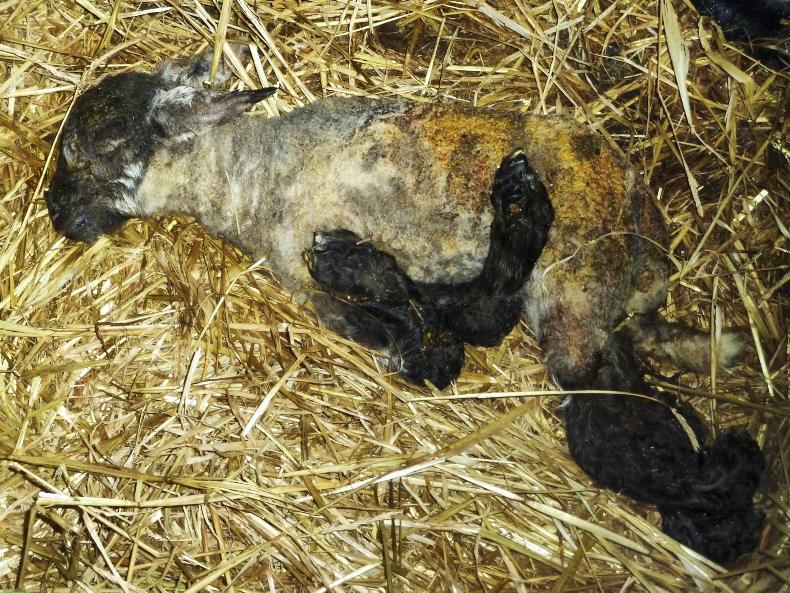What is Schmallenberg virus?
In December 2011, a new virus was identified as the cause of mild disease in cattle in Germany during late summer and autumn 2011, and foetal abnormalities in sheep, cattle and goats in the Netherlands, Germany and Belgium in November the same year.
It was named ‘‘Schmallenberg virus’’ after the German town where the virus was first identified. It is also known as SBV.
It was first detected in Ireland in October 2012.
The Department of Agriculture has confirmed two new cases of Schmallenberg in Ireland this week, the first since 2013.
How does it spread?
Schmallenberg virus is primarily spread by biting insect carriers such as the Culicoides midge, which transmits the virus during the vector season (April to November).
The virus can also infect the foetus of animals infected during the early stage of pregnancy. This may lead to abortion, stillbirth or the birth of weak, malformed newborn animals.
What does Schmallenberg virus look like?
At this time of year, the virus affects newborn animals and foetuses of ruminant animals such as cattle, sheep and goats. The symptoms are:
Congenital abnormalities in aborted animals and in animals born alive or dead.Bent limbs and fixed joints (arthrogryposis), stiff necks (torticollis), curved spines (scoliosis), shortened lower jaw (brachygnathia).Central nervous signs: ‘‘dummy’’ calves, blindness, ataxia, recumbency, an inability to suck and sometimes fits.During the vector season (April to November), adult cattle will show signs such as:
Fever, off food, reduced milk yield and sometimes diarrhoea.Affected animals recover fully within a few days.Herds are affected for two to three weeks.What should I do if I suspect I have a case of Schmallenberg on my farm?
Farmers are asked to contact their veterinary practitioner if they encounter cases of aborted foetuses or newborn animals showing malformations or nervous signs.
Veterinary practitioners should contact their Regional Veterinary Laboratory for advice on appropriate laboratory tests.
Is there a risk to humans?
There is no evidence to date of disease in people at greatest risk of infection, such as vets and farmers. The European Centre for Disease Prevention and Control has determined that the Schmallenberg virus is unlikely to cause illness in people and the risk posed by milk and meat is also considered negligible by the World Animal Health Organisation (OIE).
What are the recommendations on treatment and control of Schmallenberg?
There is no treatment currently available for this disease.
There is a vaccine available but it is not currently available in Ireland as it was discontinued due to lack of demand here in recent years.
Even if the vaccine were available, this is not the time of year to use it.
What is Schmallenberg virus?
In December 2011, a new virus was identified as the cause of mild disease in cattle in Germany during late summer and autumn 2011, and foetal abnormalities in sheep, cattle and goats in the Netherlands, Germany and Belgium in November the same year.
It was named ‘‘Schmallenberg virus’’ after the German town where the virus was first identified. It is also known as SBV.
It was first detected in Ireland in October 2012.
The Department of Agriculture has confirmed two new cases of Schmallenberg in Ireland this week, the first since 2013.
How does it spread?
Schmallenberg virus is primarily spread by biting insect carriers such as the Culicoides midge, which transmits the virus during the vector season (April to November).
The virus can also infect the foetus of animals infected during the early stage of pregnancy. This may lead to abortion, stillbirth or the birth of weak, malformed newborn animals.
What does Schmallenberg virus look like?
At this time of year, the virus affects newborn animals and foetuses of ruminant animals such as cattle, sheep and goats. The symptoms are:
Congenital abnormalities in aborted animals and in animals born alive or dead.Bent limbs and fixed joints (arthrogryposis), stiff necks (torticollis), curved spines (scoliosis), shortened lower jaw (brachygnathia).Central nervous signs: ‘‘dummy’’ calves, blindness, ataxia, recumbency, an inability to suck and sometimes fits.During the vector season (April to November), adult cattle will show signs such as:
Fever, off food, reduced milk yield and sometimes diarrhoea.Affected animals recover fully within a few days.Herds are affected for two to three weeks.What should I do if I suspect I have a case of Schmallenberg on my farm?
Farmers are asked to contact their veterinary practitioner if they encounter cases of aborted foetuses or newborn animals showing malformations or nervous signs.
Veterinary practitioners should contact their Regional Veterinary Laboratory for advice on appropriate laboratory tests.
Is there a risk to humans?
There is no evidence to date of disease in people at greatest risk of infection, such as vets and farmers. The European Centre for Disease Prevention and Control has determined that the Schmallenberg virus is unlikely to cause illness in people and the risk posed by milk and meat is also considered negligible by the World Animal Health Organisation (OIE).
What are the recommendations on treatment and control of Schmallenberg?
There is no treatment currently available for this disease.
There is a vaccine available but it is not currently available in Ireland as it was discontinued due to lack of demand here in recent years.
Even if the vaccine were available, this is not the time of year to use it.






SHARING OPTIONS